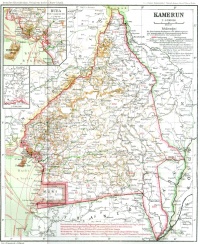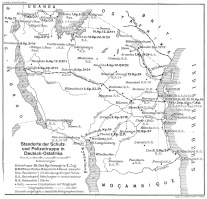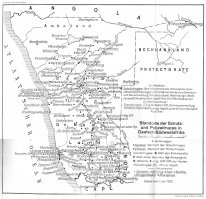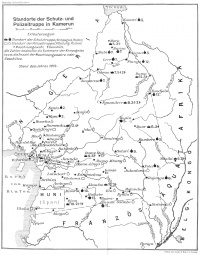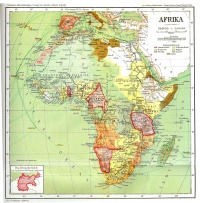Introduction↑
Most of the scholarly literature on the First World War in Africa focuses on the military campaigns fought on the continent, particularly in East Africa, the experience of African soldiers and supply carriers, and the impact of the conflict on some African territories. When the First World War began in August 1914, the European colonization of most of Africa was just twenty years old, African resistance had been recently suppressed in many areas, and the building of colonial infrastructure such as roads, railways and bridges was in the early stages. The “Scramble for Africa” had been a competitive process. There had been a few tense incidents, such as between the British and French at Fashoda in 1898, and between the French and Germans over Morocco in 1905 and 1911. Yet European powers had not fought each other over the occupation of the continent; cooperation had become the norm. As a result, the African colonies did not represent a central feature of European pre-war military planning. The fighting that broke out in Africa between the Allied Powers and Germany represented a departure from established inter-colonial relations. This article will examine European military planning in Africa, the war objectives related to Africa that developed as the war progressed, and colonial military resources in Africa.
Pre-war Planning↑
Great Britain↑
By 1914, the European powers had formulated a few limited plans for their African colonies in the event of war in Europe. In 1897, given German support for the Boer republics in what would become South Africa and the rise of the German navy, the British government created plans for the conquest of German East Africa in order to complete the dream of British rule from Cape to Cairo. The plan was never formally approved, and by 1911 London was still trying to acquire information on German forces in East Africa. In 1907 the British administration of Nyasaland developed defence plans for possible invasion from German and Portuguese territory. In the Gold Coast (today’s Ghana) the British had a plan to defend the territory’s northeast and the lower Volta River from a possible attack from neighbouring German Togoland. However, there was no provision for British offensive operations or cooperation with the French; the plan was quickly outdated by the opening of an important German wireless station at Kamina just before the war.
Germany↑
In 1891, the German Kaiser had decided that in the event of war with Britain, he would sacrifice German Southwest Africa to focus on the defence of German East Africa. This would undermine British naval supremacy in the Indian Ocean and Persian Gulf, and block the British ambition of north-south domination in Africa. None of this came to pass, however, when war eventually broke out. On the eve of the First World War, the Germans also desired to expand South West Africa northward at the expense of the Portuguese in poorly defended southern Angola. By November 1913, the German plan to defend Cameroon focused on abandoning the narrow disease-prone coast and defending the healthier highlands of the interior northeast.
Military Objectives↑
Far from the main theatre of operations in Western Europe, the African campaigns of the First World War were and are often referred to as a “side show.” Indeed, Lord Horatio Herbert Kitchener (1850-1916), Britain’s secretary of state for war and a veteran of many African colonial campaigns, firmly believed that it was pointless for the Allies to invade Germany’s African territories. He argued that when the war was won in Europe, the Germans would surrender their colonies in the subsequent negotiations.
However, Allied operations against German East Africa were launched without Kitchener’s knowledge when he was visiting Gallipoli.[1] The Allies’ immediate concern about Germany’s African colonies was the wireless relay station in Togoland that enabled Berlin to communicate with South America and ships in the south Atlantic. They were also concerned about the port facilities of German South West Africa and East Africa that could service Germany’s naval raiders, such as the Königsberg in the south Atlantic and Indian oceans.
Once these early objectives were met, the main goal of all the Allied Powers in Africa became the occupation of German colonial territory in what seemed like a completion of the “Scramble for Africa” or perhaps a second “Scramble for Africa.” Beyond what was envisaged by London, self-governing dominions of the British Empire often had expansionist ambitions of their own. Prime Minister Louis Botha (1862-1919) of the Union of South Africa, founded in 1910, saw the war as an opportunity to expand his new country by occupying German South West Africa and taking a leading role in the East African campaign. He did so with a view, ultimately, to trade German territory for the valuable ports of Beira and Lorenzo Marques in the southern part of Portuguese Mozambique.
Although initially encouraged by Britain to remain neutral, militarily weak Portugal entered the war in March 1916 primarily to acquire the Kionga Triangle on the northern border of Mozambique, which it had lost to Germany during the late 19th century. Britain and France made a deal that the latter could take the lion’s share of Germany’s West African territory – most of Togoland and Cameroon – if it stayed out of the scramble for German East Africa. In fact, British concern about preventing French claims in East Africa led to the rejection of a proposal to use French colonial troops from Madagascar to fight in German East Africa, even when the campaign was not going favourably for the Allies.
During the East African campaign, relations between British, Belgian and Portuguese forces was dominated by the prospect of who would get what territory after the war. Belgium initially desired to keep its Congo territory neutral, since it could not spare troops to send to defend it. This changed because captured African territory might be used to recover parts of the small mother country that had been occupied by Germany, or to gain a larger Atlantic coastline for the Congo.[2] While German civilian administrators often preferred to declare the neutrality of colonial Africa to preserve colonial development and white supremacy, German military leaders in Africa often felt a need to engage the Allies to draw off resources from the main theatre in Europe and maintain a foothold in Africa with a view to future negotiations.
In North Africa, the campaigns of the First World War focused on control of the strategically vital Suez Canal that facilitated shipping between India and Britain. When the First World War broke out, Egypt was occupied by Britain but was still technically part of the Ottoman Empire. In December 1914, in response to the Ottoman sultan’s declaration of jihad against the Allied Powers, Britain declared a protectorate over Egypt and replaced the pro-Ottoman Egyptian ruler. London quickly brought in 70,000 Australian, New Zealand and Indian soldiers to defend the Suez Canal. In 1915, the Ottoman Empire, supported by Germany, embarked on an ultimately unsuccessful plan to attack the Suez Canal with the aim of blocking Allied shipping and stimulating an Egyptian nationalist uprising.
Similar ambitions prompted Ottoman and German support for a rebellion by the Sanussi Brotherhood, which advocated a strict version of Sunni Islam and had a history of anti-colonial resistance, on the border of Italian-ruled Libya and British controlled Egypt. Territorial expansion also influenced Allied operations in North Africa as the British in Sudan invaded the Sultanate of Darfur in 1915. They did so on the pretext that German and Ottoman agents were active there, when in reality they wanted to secure it from a possible French thrust from Chad.[3]
Military Resources↑
Germany↑
The German colonies in Africa were isolated from each other, defended by minimal forces, surrounded by enemy territories and cut off from the mother country by the powerful British navy. To defend Togoland, the Germans relied on 152 paramilitary police, 416 regular police and 125 border guards with outdated carbines and four machine guns. Although the acting German governor of Togoland proposed that the West African territories remain neutral, the Allies saw this as a sign of weakness. In 1914 the Schutztruppen (German colonial troops) in Cameroon numbered 205 European officers and 1,650 African soldiers. With the addition of German settler reservists and colonial police, the force grew to 1,460 Europeans and 6,550 Africans formed into thirty-four companies. While the Germans had sixty machine guns and about half their force possessed up-to-date rifles, there was a serious shortage of ammunition, which they tried to manufacture locally with mixed results. Communications were also limited.
In South West Africa, seen as a white settler colony in which black military recruitment was forbidden, the Germans had around 2,000 mounted infantry and a reserve of 3,000 volunteer infantry supported by field guns, maxim guns, railway transport, wireless communications, and three airplanes. However, these forces were dispersed throughout the territory in 132 small units, later formed into four composite battalions. The Germans had plenty of artillery – forty-six heavy guns, eleven rapid firing cannon, and nine light mountain guns – and ample ammunition. However, during the campaign the artillery ran out of shells because there was no fodder for the draught animals that pulled the wagons. Food supplies were limited because the settlers concentrated on cattle ranching. Agricultural production among the Ovambo in the north was poor because of drought.
At the outbreak of the war, the Germans in East Africa had 218 European and 2,542 African soldiers. By January 1916 they had mobilized 2,712 Europeans, 11,367 Africans, and 2,591 auxiliaries. With the July 1915 sinking of the Königsberg in the Rufigi Delta, men, artillery, small arms, and ammunition from the warship were put to use by German land forces under Paul von Lettow-Vorbeck (1870-1964). The Germans controlled movement on Lake Tanganyika, where they had five vessels compared to the Belgians’ one.[4]
France↑
France was the most active employer of armed African troops during the First World War and the only major power to send them to the Western Front on a large scale. A decade before the war’s outbreak, Paris had made plans to use colonial African troops in the defence of the motherland threatened by a growing German army. In August 1914 the French maintained 20,000 African troops in West and Equatorial Africa and twenty-one battalions of tirailleurs senegalais in West Africa and Morocco. When the conflict began in 1914, the French imported over 10,000 North African soldiers to throw into the path of the invading Germans. Initially, French authorities were slightly sceptical about the military capabilities of West African soldiers and tended to use them as garrison troops to free up French units for the Western Front or for secondary operations such as in Gallipoli and the Balkans.
In early August 1914, ten West African battalions, some 10,000 men, were shipped to France. On 21 August 1914, the first West African troops saw combat on the Western Front as part of the failed French attack into Alsace Lorraine. By November 1918, given massive recruiting campaigns in which chiefs compelled members of servile classes to enlist and false promises of colonial reforms were made, around 134,000 black soldiers from French West Africa had fought on the Western Front; around 30,000 had died.[5] While French authorities initially considered Malagasy men insufficiently martial to fight and relegated the 7,500 tirailleurs malgaches to defend their island, the losses of the Battle of Verdun prompted the recruitment of 46,000 soldiers from Madagascar, though there was difficulty in finding enough ships to transport them to Europe.[6]
Great Britain↑
In 1914 Britain’s African colonies contained a small military establishment primarily meant to maintain internal security. Preparation for war occurred after the commencement of hostilities. The British territories of Kenya, Uganda and Nyasaland (today’s Malawi) were each garrisoned by a battalion of the King’s African Rifles (KAR), a colonial infantry force with white officers and black soldiers. In 1911 a fourth KAR battalion based in Nyasaland had been disbanded, with many of its members crossing the border to join the German forces. In 1914 the KAR consisted of seventy British officers leading 2,300 African soldiers. With the Africanization of the German East Africa campaign in 1916, the KAR was expanded to 30,000 troops, with the original battalions becoming regiments of several battalions each.[7]
Colonized by Cecil Rhodes’ (1853-1902) chartered British South African Company (BSAC), Northern and Southern Rhodesia (today’s Zambia and Zimbabwe, respectively) did not have formal military establishments and were defended by white and black paramilitary police. In 1914 detachments of these police forces seized the Caprivi Strip in German South West Africa. They formed the nucleus of a growing British force (eventually called the Nyasaland Field Force) between lakes Nyasa and Tanganyika that would eventually invade German East Africa from that direction.[8]
With its small British settler population eager to participate in the war to secure future political concessions from Britain, Southern Rhodesia formed ad hoc infantry units for service mostly in Africa. The entirely white 1st Battalion of the Rhodesia Regiment helped suppress the Afrikaner rebellion in South Africa and participated in the South African invasion of German South West Africa. While a Second Battalion of the Rhodesia Regiment then fought in the early phase of the German East Africa campaign, problems recruiting from the small white community prompted the formation of the white officered and primarily black Rhodesia Native Regiment in 1916 that fought in the final phase of that campaign.[9]
In 1914 the West African Frontier Force (WAFF) consisted of five infantry battalions and two field artillery batteries in Nigeria, one infantry battalion and a field artillery battery in the Gold Coast, one infantry battalion in Sierra Leone, and an infantry company in the Gambia. Its total strength was 7,552 men.[10] Fears of nationalist uprising and defections to the Sanussi made the British hesitant to employ Egyptian soldiers in the First World War. However, Egyptian officers remained remarkably loyal to the British and Egyptians served outside their country. For instance, Egyptian artillery supported the Arab uprising against the Ottomans, a 170,000 strong camel transport corps served in the Middle East, and 23,000 Egyptians laboured in France and the Middle East.[11]
In 1914 the Union Defence Force (UDF), South Africa’s military that was less than two years old, consisted of a permanent force of 2,500 South African Mounted Rifles, an Active Citizen Force of 23,000 volunteers and conscripts receiving part-time training, and a reserve of local rifle associations and commandos. Britain saw South Africa, like the other dominions, as a source of manpower to defend the mother country; the Union government saw an internal Afrikaner rebellion as its primary security threat. Given the link between military service and citizenship rights, the UDF was exclusively white, with black enlistment subject to special permission from parliament.[12]
During the Afrikaner Uprising of 1914, Botha rejected offers of imperial assistance and rallied 32,000 loyalist white troops to suppress 11,500 rebels. In 1915, for the invasion of German South West Africa, South Africa mobilized 45,000 European soldiers and 33,000 unarmed African, mixed race and Indian volunteers who worked as transport drivers and general labour. Several South African pilots were recalled from the new Royal Flying Corps in Western Europe to provide aerial reconnaissance for the invasion.
While white Afrikaner nationalists in South Africa opposed sending soldiers to Europe to help the British, whom they had fought just a dozen years earlier, the patriotic white English-speaking community demanded an opportunity to serve Britain directly. The 5,800 strong 1st South African Infantry Brigade left Cape Town in August 1915. After training in Britain and a brief stint in Egypt fighting the Sanussi, the brigade was shipped to Western Europe in April 1916 for the anticipated Somme offensive. They remained there for the rest of the war.
Black and coloured (mixed race) political leaders in South Africa suspended protest against racial discrimination during the war and urged the government to provide an opportunity for their people to earn citizenship rights through military service. The failure of a recruiting drive among whites for the East Africa campaign led to the founding, in December 1915, of the Cape Corps. Consisting of 1,000 armed coloured volunteers under white officers, the unit represented a radical departure from the principle of an all-white UDF. Responding to white fears, the Botha administration pointed out that this force was paid by imperial rather than South African funds and therefore would have no local claims.
In June 1916 the Imperial War Council, anxious about a shortage of military labour behind the lines in Western Europe, requested African workers from South Africa and other colonies. Botha responded positively and recruiting began for the South African Native Labour Contingent (SANLC). Realizing that South African whites feared that blacks serving in Europe might return home with potentially dangerous new ideas, Botha did not take the issue to parliament as the contingent was meant for imperial service. Around 21,000 SANLC men served in France between September 1916 and January 1918 cutting timber, loading and unloading ships, and maintaining road and rail systems. Members of South Africa’s Coloured community also served as unarmed military labour in Europe, including two battalions of dock workers from Cape Town who unloaded ships at French ports, a 2,000 strong labour battalion, and 3,500 men of the Cape Auxiliary Horse Transport.[13]
Belgium↑
Belgium’s 15,000 strong Force Publique in the Congo represented the largest single territorial colonial military force in Sub-Saharan Africa in 1914. However, it was spread over a huge colony with minimal transportation infrastructure, had the lowest proportion of European officers to African troops of all colonial armies in the continent, and had a recent history of ill-discipline and mutiny.[14]
Conclusion↑
With the exception of the French plan to employ African soldiers in defence of the metropole, colonial Africa did not represent a priority in European war planning on the eve of the First World War. Once the Allies achieved the immediate and globally significant military objectives of securing the coastlines of the German colonies, the African campaigns moved into the interior where local colonial interests came to the fore and operations turned into a continuation or perhaps conclusion of the earlier “Scramble for Africa.”
Just prior to the war, most European-led colonial militaries in Africa were small and underequipped, and were meant to enforce the subjugation of the indigenous people through, for example, the extraction of taxation and forced labour. They were not meant to defend their colonies from invasion or to mount invasions of other territories, which is what they suddenly had to do during the Great War. To meet the manpower demands of the conflict, all the European powers and the self-governing British dominion of South Africa dramatically expanded their existing colonial forces, though only the French sent large numbers of fighting troops outside Africa.
Although Africa represented a “side show” in terms of planning and objectives, the First World War would have a remarkable impact on African people who served as soldiers and labourers, provided agricultural resources for the war effort, at times saw an opportunity for renewed resistance with the weakening of the colonial state, and in some places witnessed the violent departure of German colonial rulers.
Tim Stapleton, Trent University
Section Editors: Melvin E. Page; Richard Fogarty
Notes
- ↑ Samson, Anne: World War I in Africa. The Forgotten Conflict among the European Powers, London 2013, pp. 193-96.
- ↑ Samson, World War I 2013, pp. 166-85.
- ↑ McGregor, Andrew: A Military History of Modern Egypt. From the Ottoman Conquest to the Ramadan War, Westport 2006, pp. 201-19.
- ↑ Strachan, Hew: The First World War in Africa, Oxford 2004, pp. 14, 21f, 76, 102, 122,
- ↑ Marc, Michel: L’Appel, à l’Afrique. Contributions et réactions à l'effort de guerre en A.O.F. (1914-1919), Paris 1982.
- ↑ Fogarty, Richard: Race and War in France. Colonial Subjects in the French Army, 1914-1918, Baltimore 2008, pp. 39-44.
- ↑ Strachan, First World War 2004, pp. 104, 166; Anderson, Ross: The Forgotten Front. The East African Campaign, 1914-1918, Stroud 2004, p. 20.
- ↑ Gibbs, Peter/Phillips, Hugh/Russell, Nick: Blue and Old Gold. The History of the British South African Police, 1889-1980, Johannesburg 2009, pp. 155-64.
- ↑ McLaughlin, Peter: Ragtime Soldiers. The Rhodesian Experience in the First World War, Bulawayo 1980; Stapleton, Timothy: No Insignificant Part. The Rhodesia Native Regiment and the East African Campaign of the First World War, Waterloo 2006.
- ↑ Haywood, A.H.W./Clarke, F.A.S.: The History of the Royal West African Frontier Force, Aldershot 1964; Strachan, First World War 2004, p. 22.
- ↑ McGregor, Military History 2006, pp. 215-19.
- ↑ Seegers, Annette: The Military in the Making of Modern South Africa, London 1996, pp. 12-22.
- ↑ Nasson, Bill: Springboks on the Somme. South Africa and the Great War, 1914-1918, Johannesburg 2007, pp. 35-59, 63-87.
- ↑ Lisolo na Bisu (Our History): The Congolese Soldier of the Force Publique, Brussels, p. 29; Samson, World War I 2013, p. 33.
Selected Bibliography
- Anderson, Ross: The forgotten front. The East African campaign, 1914-1918, Stroud 2004: Tempus.
- Echenberg, Myron J.: Colonial conscripts. The Tirailleurs Sénégalais in French West Africa, 1857-1960, Portsmouth; London 1991: Heinemann; J. Currey.
- Fogarty, Richard: Race and war in France. Colonial subjects in the French army, 1914-1918, Baltimore 2008: Johns Hopkins University Press.
- Grundlingh, Albert M.: Fighting their own war. South African Blacks and the First World War, Johannesburg 1987: Ravan Press.
- Hodges, Geoffrey: Kariakor. The carrier corps. The story of the military labour forces in the conquest of German East Africa, 1914 to 1918, Nairobi 1999: Nairobi University Press.
- Jackson, Ashley: Bechuanaland, the Caprivi Strip and the First World War, in: War and Society 19/2, 2001, pp. 109-142.
- Lunn, Joe Harris: Memoirs of the maelstrom. A Senegalese oral history of the First World War, Portsmouth; Oxford; Cape Town 1999: Heinemann; J. Currey; D. Philip.
- McGregor, Andrew James: A military history of modern Egypt. From the Ottoman conquest to the Ramadan War, Westport 2006: Praeger Security International.
- McLaughlin, Peter: Ragtime soldiers. The Rhodesian experience in the First World War, Bulawayo 1980: Books of Zimbabwe.
- Michel, Marc: L'appel à l'Afrique. Contributions et réactions à l'effort de guerre en A.O.F. (1914-1919), Paris 1982: Publications de la Sorbonne.
- Nasson, Bill: Springboks on the Somme. South Africa in the Great War, 1914-1918, Johannesburg; New York 2007: Penguin.
- Page, Melvin E.: The Chiwaya war. Malawians and the First World War, Boulder 2000: Westview Press.
- Page, Melvin E. (ed.): Africa and the First World War, New York 1987: St. Martin's Press.
- Paice, Edward: Tip and run. The untold tragedy of the Great War in Africa, London 2007: Weidenfeld & Nicolson.
- Samson, Anne: World War I in Africa. The forgotten conflict among the European powers, London; New York 2013: I. B. Tauris.
- Samson, Anne: Britain, South Africa and the East Africa campaign, 1914-1918. The union comes of age, London; New York 2006: I. B. Tauris; St. Martins Press.
- Seegers, Annette: The military in the making of modern South Africa, London; New York 1996: Tauris Academic Studies.
- Stapleton, Timothy J.: No insignificant part. The Rhodesia Native Regiment and the East Africa Campaign of the First World War, Waterloo 2006: Wilfrid Laurier University Press.
- Strachan, Hew: The First World War in Africa, Oxford; New York 2004: Oxford University Press.





